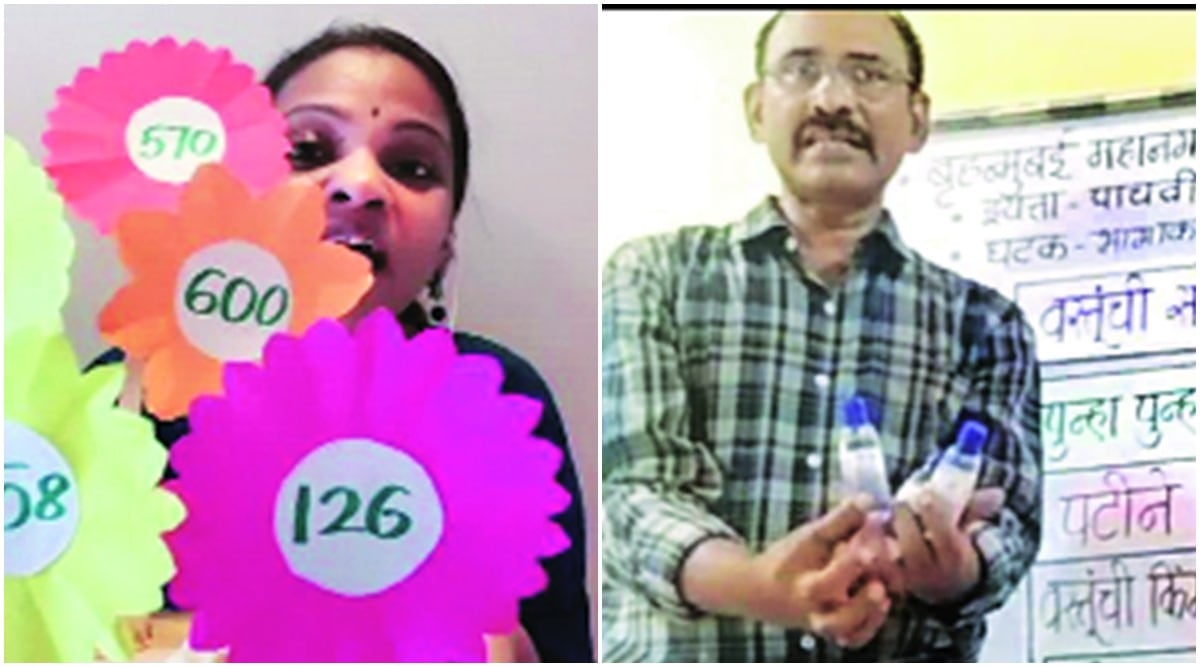 Teachers of several civic-run schools have adapted to
online teaching. Some have been using puppets, colourful charts to teach students.
Teachers of several civic-run schools have adapted to
online teaching. Some have been using puppets, colourful charts to teach students.Like most teachers, Madhura Godbole would have, in ordinary circumstances, reprimanded students for using mobile phones in class, that is until mobile phones became the norm. On Wednesday, her lecture was streamed for Class V students, a new normal she is still getting used to.
Godbole (53) teaches at a Marathi medium civic-run school in Santacruz and is trained in the use of online tools for teaching. But she admits she was unusually nervous Wednesday. “The lecture was streamed live using Zoom. It was to be recorded and uploaded on YouTube for all to see. Students across the state would see it. Officials would view it. It was all a bit unnerving,” said Godbole, recounting the experience.
With civic school campuses still shut due to the Covid-19 outbreak, Godbole is one of the many teachers who has adapted to online teaching. Initially she would use household accessories to balance her phone during recording, but eventually she purchased a tripod stand. “Now as we are broadcasting live using Zoom and YouTube, I’m using my husband’s laptop,” she added.
Starting August 10, the Brihanmumbai Municipal Corporation (BMC) has launched 40 dedicated YouTube channels — one each for Class 1 to 10 in four different languages — to broadcast lectures by its own teachers like Godbole. The result is, 250 hours of weekly programming for Class I-10 students available to any household on a basic smartphone.
Lack of smartphones and absence of resources for “instant phone recharges and data packs” were found to be key barriers to remote learning during a citywide survey commissioned by the BMC and conducted by NGO Pratham earlier this month. Pratham says it interviewed 6,673 parents across 52 civic schools in 12 wards to “understand the access to and response to online learning content.”
Getting more creative with low-tech form of instruction, the BMC is experimenting with YouTube channels to enhance e-learning. Based on the Pratham survey findings, plans are also to use radio programming and SMS-based teaching.
BMC’s education officer Mahesh Palkar said, “Streaming on YouTube is faster and simpler than other platforms. It consumes less data. It is also popular with students and parents.” Palkar indicated that the YouTube service can also be used as a forum to reach out to students who have migrated during the lockdown. According to civic data, until August 3, while 2,46,626 students were enrolled in civic schools, 81,603 were yet to be connected online. Of this, 52 per cent are children of migrant workers who have left the city.
According to Palkar, 9,482 students had participated in the lectures that took place on August 10. By August 12, this had risen to 19,170. Godbole is one of 250 civic teachers shortlisted for delivering the Zoom lectures. “Community engagement is one big element that kids are missing these days. So to have an actual face of a teacher bringing those lessons seemed like a good idea,” said Joint Municipal Commissioner Ashutosh Salil. The teachers have undergone intensive training in remote learning techniques and use of tools. To monitor the quality of lectures and plan the schedule for the lectures, the civic body has also appointed 40 tech savvy teachers as channel nodal officers (CNO) who communicate with the lecturers and plan the presentations to be made. “Those scheduled to conduct lectures share their presentations with us one day prior. We check the lesson plan, guide them on voice modulation, gestures and check if the content is easy to understand,” said Shreeraamulu Devasani, one of the CNO.
Students are taught how to use the chat box, “raise hand” option, “start video” option, among other features. At the end of the class, students are encouraged to raise queries. “This allows us to evaluate whether a concept has been clearly understood by the students or not. Apart from the lessons, we make sure that the teacher also talks about precautions for Covid-19 and healthy diet,” Devasani adds.
Two teachers are usually deputed for one teaching session. If the teacher conducting the class experiences connectivity or other technical issues, the second one continues with the lecture. Teachers are already making interesting additions to the teaching plan. Some have been using puppets, colourful charts to teach students.